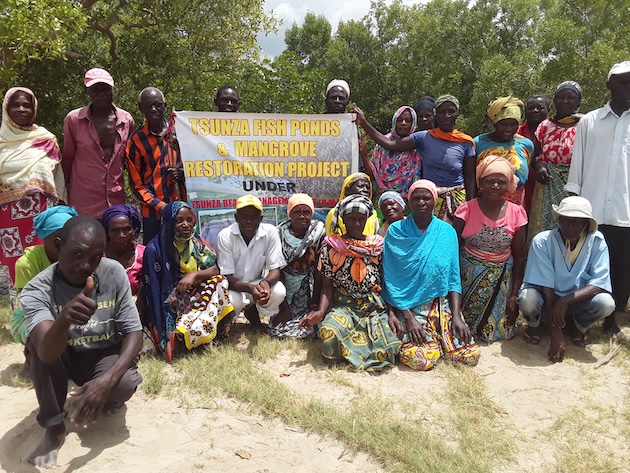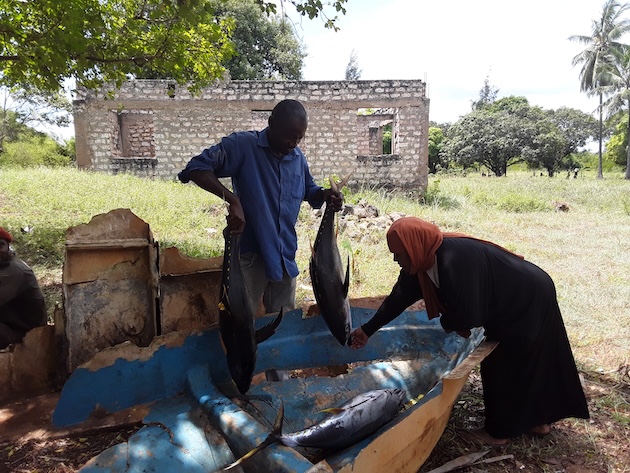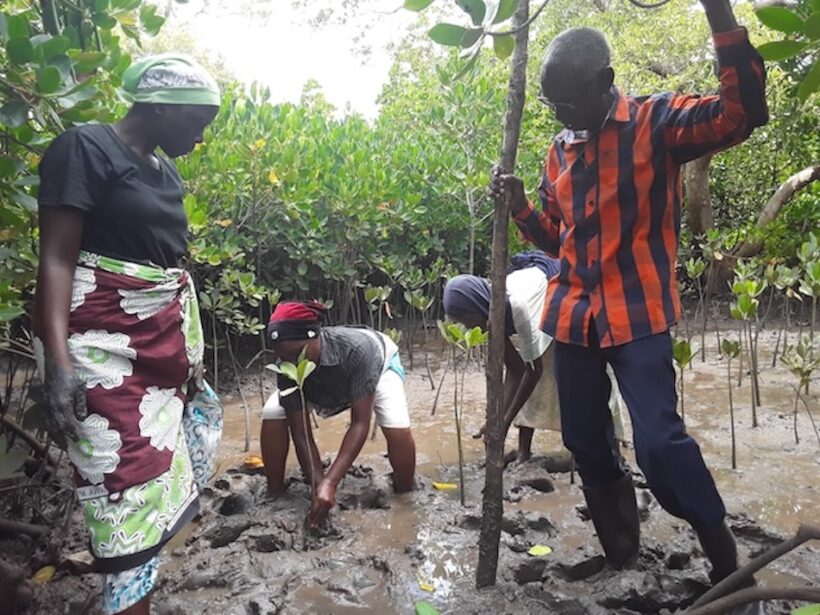Fish disappeared from the sea near Tsunza, a village on the Kenyan coast, after several oil spills between 2003 and 2006. This, combined with the disappearance of the mangroves, has had a serious impact on the livelihoods of the women. Now they are the defenders of their restoration.
By Joyce Chimbi
Tsunza Peninsula is a natural wonder nestled among the many inlets of Mombasa Island, on the border between Mombasa and Kwale counties, a little-known spectacle of lagoons, islands, and dense mangroves in Kinango, on Kenya’s Indian Ocean coast.
This natural paradise is a hive of activity, with fishermen roaming the creeks and returning to shore after a sunrise harvest. Small sailboats, known locally as dhows, and motorboats glide from coast to coast as tourists and locals travel between the two neighboring counties.
What holds these activities together are the efforts of the 45 people, 35 of them women, of the Tsunza Mangrove and Fish Pond Restoration Community Project.
They protect, conserve, maintain, and restore the Tsunza mangrove forest and the entire ecosystem. Mangroves are not only a biodiversity hotspot but also coastal superheroes, a first line of defense against climate-related coastal hazards.

The Tsunza Peninsula is a natural wonder located just inside the many inlets of Mombasa Island, on the border between Mombasa and Kwale counties. Image: Joyce Chimbi / IPS

Tsunza is a little-known magical spectacle of lagoons, islands and dense mangroves in Kinango, Kwale County, in Kenya’s coastal region. Image: Joyce Chimbi / IPS
Mangroves are one of the most carbon-rich habitats on Earth.
Their entire ecosystem of seagrasses, coastal marshes and coral reef vegetation is known as a blue forest because it captures large amounts of carbon dioxide from the atmosphere and stores it in natural sinks known as blue carbon.
Its complex structure and root systems provide a haven for fish and other aquatic species to live, eat, and reproduce, keeping them within reach of fishermen.
“Tsunza used to be a quiet village, especially in the years following a series of mysterious oil spills between 2003 and 2006. More than five million liters of oil spilled into the Indian Ocean and into the mangroves. More than three million seedlings were destroyed,” Lucy Kazungu of Tsunza village, one of the four community project leaders, told IPS.
She added: “The mangrove was threatened and the fish disappeared into the depths of the water. Where Tsunza was once the main fish producer on the coast, Tsunza Bay became a no-take zone for fish.
Mangroves are high-value trees, preferred for building materials, charcoal, and firewood. As a result, mangroves in Tsunza and along Kenya’s coastline, which is estimated to be 1,420 kilometers long, have been cleared and severely degraded.
Overall, the country lost about 20% of its mangrove cover between 1985 and 2009, which translates into an annual loss of 450 hectares of mangrove forest.
According to government data, more than 2.5 million people live in communities adjacent to mangrove forests and rely heavily on their resources for their daily survival and economic activities.
Minority and indigenous ethnic groups that dominate the Kenyan coast, including the Digo, Duruma, Shirazi, Wapemba and Wagunga, have been pushed to the frontline of climate change.

Members of the Tsunza Community Mangrove and Fishpond Restoration Project protect, conserve and restore the mangrove forest and the entire ecosystem. Image: Joyce Chimbi / IPS

The complex root system and structure of the mangroves provide a safe haven for fish, a place for them to live, eat and breed, bringing them closer to the fishermen. Image: Joyce Chimbi / IPS
Women have been particularly hard hit. The loss of mangrove cover and the entire ecosystem of marshes, shrubs, coral reefs, mudflats and seagrass, which were already vulnerable and largely excluded, meant even greater exposure to serious coastal hazards and loss of livelihoods.
“Fish started to disappear and only those who could fish in the deep water were fishing. Women were badly affected because we used to buy fresh prawns and dagga (silver cyprinid) fish from the fishermen, which we fried and hunted,” Hamisi Juma, a resident of Vanga Bay, adjacent to the Vanga Blue Forest, told IPS.
She said: “This is the main source of income for women along the coast. Women depend on small fish and they are often the first to leave when the weather conditions are bad for them.
“Then came the floods. We did not know that the mangroves were a wall protecting us from the sea. Our rice plantations, which are also dominated by women, were destroyed. Our young children could not go to school during the heavy rains because of the flooding,” she recalls.
The destruction of the mangroves in Vanga Bay was particularly severe. Between 1991 and 2016, the community overexploited mangroves at a rate of 0.5% per year, resulting in the loss of 451 hectares of mangroves in 25 years.
“The coastal communities were unaware that mangrove forests and swamps, and the entire ecosystem of seagrasses and marshes, are the most important ecosystems in the fight against climate change,” said independent researcher Omar Hassan Aden.
The climate change expert added that “without the ecosystem to act as a barrier between the community and the deadly waters of the Indian Ocean, it would be a disaster as we saw in Libya, where a quarter of a city was destroyed by storms and floods in 2023”.
But as science reaches the community, women are emerging from the frontlines of climate change with the knowledge, determination and commitment to be at the heart of climate action. Planting and nurturing mangrove seedlings to restore coastal mangrove forests, while contributing significantly to conservation and protection efforts.
“As women, we are the silent defenders of mangrove conservation. Last year, we planted over 300,000 seedlings. We don’t just plant them in the ground, we nurture them until they can grow on their own,” said Kwekwe Tsuma from Tsunza village.
He added: “Tsunza’s mangrove forest cover is one of the best, thick with very few gaps in between, and we are now being rewarded with high fish production.
“We have even started a fish pond project and the women no longer have to buy fish from fishermen. We look after the mangrove forest, sell mangrove seedlings, raise fish and also have a beekeeping project. Mangrove honey is soft, unique, delicious, one of the best, and cures various diseases,” said the environmentalist.
There are 8536 hectares of mangroves in Kilifi, 8354 hectares in Kwale and 37,650 hectares in Lamu, representing 61% of the total mangrove cover, according to the latest statistics from the Kenyan Ministry of Environment and Forestry.
Research shows that about 16% of Kenya’s coastline is at high risk from coastal hazards, and this could rise to 41% if no action is taken.
In November and early December 2023, deadly El Niño floods hit the coast in regions such as Mombasa where mangrove cover is minimal. The flooding was severe.
Community-led initiatives in Kwale County, such as Tsunza and Vanga Blue Forest, are helping to restore 3725 hectares of degraded mangroves.
Kenya’s Mikoko (mangrove) Pamoja community-led committee of five women and eight men is the world’s first successful coastal ‘blue carbon’ project.
The Ngomeni Marereni community project is restoring and protecting 640 hectares of severely degraded mangroves, contributing significantly to the restoration of 3,422 hectares of degraded mangroves in Kilifi County.
In Lamu, the Mtangawanda Mangrove Restoration Women’s Group is leading mangrove conservation, protection, and restoration efforts, contributing to the restoration of 14,407 hectares of degraded mangroves.
The ongoing low-cost, high-impact, community-led, and community-driven efforts are expected to restore Kenya’s blue forest to its former natural glory and protect coastal communities from the onslaught of climate change.






